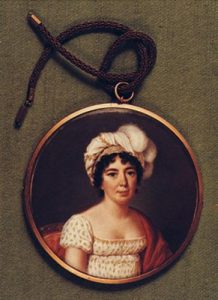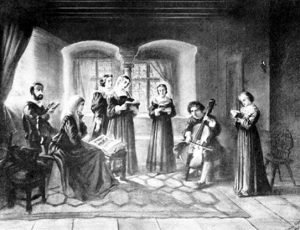Her youth
Germaine de Staël was born in Paris in 1766. She was the daughter of the rich Protestant banker, Jacques Necker, whose forbears had had to flee to Germany and then to Geneva because of religious persecution. Her mother, Suzanne Curchod, was the daughter of a pastor of the Reformed Church in the Canton of Vaud. Her parents were deeply religious and with age this became more accentuated. They would never lower their standards in order to be accepted by French society, which they considered to be very frivolous. In fact they stood out from the crowd because of their religion and strict morality.
Madame Necker was a well-known member of high society and an outstanding person. She had been much influenced by the Enlightenment and introduced her daughter Germaine to the members of her highly influential salon, where one spoke of philosophy and politics. ‘She was clothed in virtue, protected by her shield of faith’ and she also liked to entertain writers of the ‘Encyclopedia’ such as Diderot. Other guests were Buffon, Marmontel, Grimm, Edward Gibbon, Abbé Raynal Jean-François de la Harpe etc. who gave their support to her husband. Her French guests were convinced of her husband’s brilliant political career : indeed he was to be appointed minister three times in Louis XVI’s government.
At the age of fifteen in 1780, Germaine was already avidly reading Rousseau, commenting on Montesquieu, discussing ideas with Marmontel, Grimm and Raynal; she was thus absorbing the spirit of the Enlightenment. She shared the XVIIIth century belief in Man. She was a fervent liberal and a true individualist. She believed that Man could reach perfection. She welcomed the French Revolution. “Oh people of France,” she exclaimed one day “if your enthusiasm should wane in your land, all you would leave to prosperity would be streams of dry sand …as arid as a desert”.
Germaine Necker had a temperamental love life and was married twice
She obeyed her parents in their choice of a future husband – a man seventeen years older than herself. This was Baron Erik Magnus de Staël-Holstein, the Swedish ambassador to the Royal Court in Versailles, who had been sent by King Gustave III. The marriage took place on 17 January 1786 in the Lutheran chapel of the Swedish embassy. She had a stormy relationship with Benjamin Constant, a politician and writer whom she met in 1794. He was both French and Swiss from the Canton of Vaud and also a Protestant. She had a child with him in 1797 who was called Albertine. But her romantic entanglements continued and she went on to have another child out of wedlock, Auguste, whose father was Count Louis of Narbonne. She finally separated from her husband in 1800 and became a widow in 1802. In 1811 she married a young officer from Geneva, Albert de Rocca, who was 22 years younger than her.
Her salon
Like her mother before her, Germaine de Staël opened a salon in 1792 in the Swedish ambassador’s residence in the Rue du Bac, where her guests were part of a new generation (La Fayette, Noailles, Clermont- Tonnerre, Condorcet) – they all defended the idea of a constitutional monarchy. Napoleon Bonaparte considered her to be a dangerous obstacle to his power and she had to flee several times to her father’s manor in Coppet, Switzerland notwithstanding the diplomatic status of her husband.
Her Protestant ideas deeply influenced her Christian philosophy
Germaine had been brought up by her parents according to the ideas of XVIIIth century Protestantism which were tolerance and Enlightenment. She herself stressed the importance of morality and the revelation of the ‘Supreme Being’. “The Christian religion, the most philosophical of all religions, is the one which makes Man confront his own reality” when facing death. She believed in God and defended a particularly heterodox form of Christianity, based on reason rather than faith and devoid of dogma. This is expressed in ‘Literature’, in 1800 and in ‘Delphine’ in 1802. However, in Coppet, she entrusted the children Albertine and her brother Auguste, to Pastor Jean Isaac Cellérier (1753-1844) a precursor of the Revival Movement in Geneva. “Our religion, that is to say, that of both my parents, is important to me and I don’t want my son to be separated from it”. After the Reign of Terror (1792-1793) she dreamt of a society where the same religion would be shared by all and wanted Protestantism to become the official religion in France.
Later, between 1811 and 1813, greatly influenced by mysticism, she wrote, in her book about Germany, that she believed in a perpetual revelation of God, and an inner voice which she recognized by the exaltation of her soul, an inner voice which kept her in eternal contact with God. She died in 1817, the same year in which Albertine, the elder of her two children, was married. Young Auguste witnessed the collapse of his family circle with great distress but he was called on to work for the Bible Society of Paris, where he was deeply involved. Later he fought for the abolition of slavery until his death in 1827.
The literary works of Germaine de Staël
She made her literary and intellectual reputation with three philosophical essays: Letters on the work and character of Jean-Jacques Rousseau (1788), The influence of passion on the happiness of the individual and of nations (1796), The relationship between literature and the institutions of society (1800). In her novel Delphine (1802), she expressed the political and social issues of her time, the attraction of English culture for her compatriots, the superiority of Protestantism over Catholicism and the unhappiness of women held down by their position in a patriarchal family.
Exile in Switzerland because of her political standpoint
Her salon became a centre for resistance against Napoleon Bonaparte from 1802 onwards. This led to her being forced into exile under the Consulate and the Empire by Napoleon Bonaparte who considered her an obstacle to his political power. Frequent visitors to her salon are Benjamin Constant, Auguste Wilhelm von Schlegel, Sabran, Sismondi, Bonstetten, the Voigt Barons de Balk, etc. The following returned every year: Mathieu de Montmorency, Prosper de Barante, Prince Augustus of Prussia, Mme Récamier etc. She moved to the family manor in Coppet in Switzerland, where her group, called ‘the Coppet group’, met together. In 1805, in the only place where she was able to live in Napoleonic Europe, she began ‘Corinne or Italy’, a novel in which the heroine searches for independence but dies as a result. François Guizot, only 21 years old at the time, was a member of her salon.
She was a precursor of the French Romantic Movement because she revealed German philosophical and poetic works in her book ‘About Germany’ (1811-1813) to her compatriots after travelling in Europe. She showed the Germans as a sentimental and childlike people, an image which remained powerful for the whole of the XIXth century in the minds of the French. In 1814 it was published in France but the hate she had expressed for Napoleon in its pages led to it being confiscated. She undertook a journey to Italy at the end of the same year, because, she said, “one must have a European outlook”.
She returned to Paris in the reign of Louis XVIII
In London in 1813, she met the future Louis XVIII, whom she considered to be capable of governing France. She opened her Parisian salon in Rue Royale and encouraged the restoration of the Bourbon monarchy. Her daughter Albertine acted as hostess. She was obliged to submit to the social rules typical of this extremely rich and aristocratic milieu and was married, at the age of 20, to Duke Victor de Broglie, who was 12 years older than herself. Although he was officially a Catholic, he was also open to the Revival Movement and became involved in the Society for Moral Christianity, which drew members from the Protestant and Catholic elite who wanted to further a faith which was lived out in everyday reality. As for Albertine, she founded the Women’s Bible Association in Paris. In 1817, a group known as the Doctrinaires crowded into her salon, represented by the Duke of Broglie (1785-1870), Royer-Collard (1763-1845), Barante (1782-1866), Rémusat (1797-1875) and Guizot (1787-1874); they were all favourable to a monarchy kept in check by a charter.
Germaine died in 1817, shortly after an attack of paralysis at the age of 50. She had been unable to finish Considerations on the main events of the French Revolution. In this post-humus work published in 1818, she reproached the French for being dominated by the love of abstract ideas, for their rejection of others which prevented them from taking as a model the constitution adopted by another nation. As for the Empire, she considered that it was full of civil servants for a great administrator, full of soldiers for a general, full of subjects for a Cesar and full of anarchy which makes everybody want to take power.



